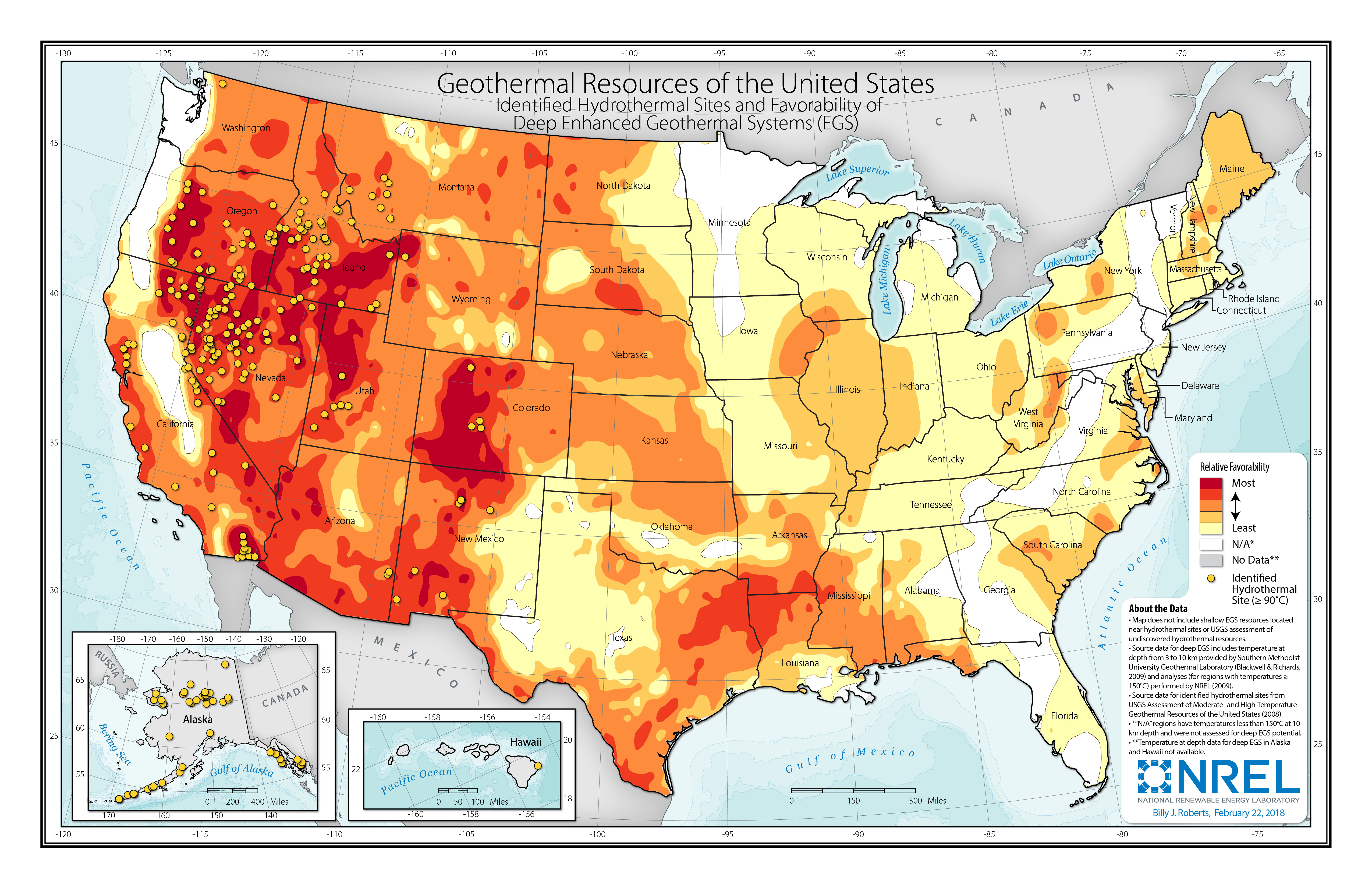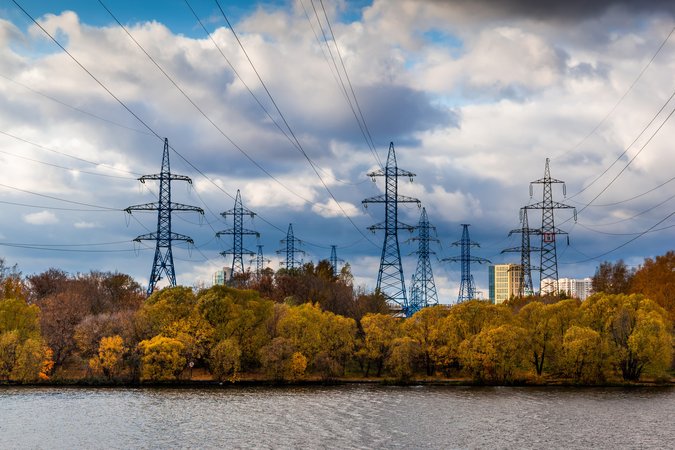Geothermal Energy 101
An overview of traditional and next generation geothermal technologies, the benefits and challenges of geothermal energy use and deployment, and the policy landscape for geothermal energy in the United States.
Geothermal energy is a renewable energy source that comes from reservoirs of hot water beneath the Earth’s surface. With applications in several economics sectors—electricity, industry, and buildings—increased use of geothermal energy has the potential to decrease the use of fossil fuels and the resulting greenhouse gas emissions. This explainer provides an overview of traditional and next generation geothermal technologies and how they work, the benefits of geothermal energy use, the challenges to increased deployment, and the policy landscape for geothermal energy in the United States.
The Status of Geothermal Energy
How Geothermal Energy Works
Most power plants use heat to generate steam that turns a turbine which ultimately generates electricity. Geothermal power plants are no exception; however, instead of burning oil or coal to create heat, they source heat from hot water inside the Earth itself. These underground hydrothermal reservoirs naturally generate heat and steam that reach Earth’s surface through hot springs, geysers, and even volcanoes. Geothermal resources and facilities are usually located on the border of Earth’s tectonic plates, where fissures allow trapped reservoirs to migrate to the surface.
Figure 1. Geothermal Resources of the United States

Electricity Generation: Geothermal Power Plants
Geothermal power plants use hot water to generate steam to turn a turbine for electricity generation. Since the heat of the water is the essential component of a geothermal power plant, these active systems are typically located where hydrothermal reservoirs exist.
There are three primary forms of geothermal power plants: dry steam, flash steam, and binary cycle.
Dry steam geothermal plants are the original type of geothermal power plant systems. Dry steam power plants use the steam provided by a hydrothermal reservoir directly to spin generator turbines.
The flash steam power plant is the most common geothermal power plant type globally and is more energy efficient than the dry steam model. Flash steam power plants operate on highly-pressurized reservoirs where the water typically exceeds 360°F. The pressure pushes the superheated water to the surface, where it enters a tank at a pressure much lower than exists underground. When the water reaches the tank, the lower pressure causes some of the water to be “flashed,” or vaporized, generating steam that turns a turbine. Water that isn’t flashed is injected back into the hydrothermal reservoir for later use.
Finally, a binary cycle power plant—the newest technology, which has accounted for the vast majority of geothermal growth in the United States and around the world in recent decades—uses two circulating tracks for fluid movement. Hydrothermal reservoir water (often at lower temperature than is needed for other types of geothermal power plants) to heat another working fluid with a much lower boiling point. The hot water is reinjected back into the reservoir while the heated working fluid becomes vaporized, generating steam that spins a generator turbine. The fluid drawn from underground, sometimes referred to as geofluid, may have CO₂ dissolved in it. While other systems use geofluid directly and allow the CO₂ to escape from the fluid, binary cycle systems do not; because the geofluid and the working fluid never come into direct contact, the CO₂ in the geofluid is not released and instead is re-sequestered underground. Therefore, binary cycle systems result in little (on a life-cycle basis) to no greenhouse gas (on an operating basis) and particulate matter emissions.
Despite these multiple use options, however, geothermal represented only 0.5 percent of net electricity generation in the US as of April 2020 and has not seen substantial growth in the US over the past few years. (More growth is happening in other parts of the world, but given that the US is still the largest net generator of electricity from geothermal, these gains continue to be fairly small.)
Non-Electricity Geothermal Applications
In addition to electricity generation, applications of geothermal energy include temperature control (both heating and cooling) and industrial processes.
Temperature control is typically provided by geothermal heat pumps--which rely on geothermal energy found only 5 to 15 feet below the surface, referred to as passive geothermal--rather than the deeper hot water reservoirs used in other applications. Geothermal heat pumps regulate temperature by exchanging air from underground--which is cooler than surface air in the summer, and warmer in the winter--with that inside the building.
District heating systems and personal direct use applications utilize the hot water near Earth’s surface either as a supply of hot water (such as that used to fill pools at a hot spring spa or for heating water at fish farms) or as a source of heat, piped from underground into buildings for heating. Geothermal systems are also used in industrial settings where heat is an essential component of a process, such as milk pasteurization or food dehydration.
Recent Advances in Geothermal Systems
In recent decades, there have been many advancements to geothermal technology that expand the range of possible resources for geothermal use.
Enhanced geothermal systems (EGS) make use of geothermal resources sourced from much deeper reservoirs than the systems discussed above. These resources are typically not economical to developers for a variety of reasons. The most common reason is that these deep reservoirs are often not permeable enough for hot water or steam to flow up to the surface. To rectify this problem, enhanced geothermal systems inject fluids into the ground at high speeds to fracture deep rock, permitting flowing channels to form and water to reach more accessible depths and deposits. Enhanced geothermal systems are typically configured as binary steam plant models and are especially useful for hot, dry rock situations.
In addition to enhanced geothermal systems, other emerging geothermal uses are enabling the use of resources that have not previously been widely used, such as low-temperature and coproduced resources. Low-temperature resources are hydrothermal reservoirs with temperatures below 300°F; they are often used in passive heating settings such as districting heating, greenhouses, and industrial processes. Low-temperature resources can even be configured in binary steam plants to generate electricity, although this practice is not as prevalent as other uses of low temperature hydrothermal reservoirs. Coproduced resources are geothermal reservoirs that are formed as a byproduct of oil and gas production activity; these hot water streams have previously been an inconvenience, but are increasingly being viewed as a potential source of clean energy.
A subset of low-temperature resources that has recently garnered attention from the US Department of Energy is direct deep use (DDU) application of geothermal reservoirs. Direct deep use applications use low-temperature resources to facilitate large-scale use across residential, commercial, and industrial facilities. In particular, low-temperature DDU is useful for applications spanning residential heating and cooling, district heating systems, industrial processes, manufacturing functions, and agricultural activity.
Benefits of Geothermal Systems
Geothermal systems are considered renewable energy resources and can offer significant economic and environmental benefits.
Predictability: Geothermal power plants can run at all times, given that their fuel source is constant. This quality renders geothermal energy a valuable baseload source of renewable power. A baseload power source is one that can generate a set amount of electricity at any given time, rather than producing varying amounts of electricity depending on external factors like the availability of wind and sun. At the same time, geothermal power plants offer more flexibility than some other types of baseload power sources, as it is relatively easy to ramp their power production up and down depending on need.
Emissions: The greenhouse gas emissions associated with geothermal system operation are considerably smaller than those generated by traditional fossil fuel sources such as oil, coal, and natural gas. For comparison, geothermal fields only emit about 17 percent of the amount of carbon dioxide produced by a natural gas plant--the lowest-emitting type of fossil-fuel plant.
Industrial Decarbonization: Many industrial processes currently rely on fossil fuels to produce necessary heat levels. As described above, geothermal energy could substitute for fossil fuels in some processes that would be difficult to electrify.
Longevity: Geothermal heat pump equipment has a very long expected life, leading to significant longevity of these heating and cooling systems. The US Department of Energy estimates that the heat pumps themselves have more than 20-year life spans, while the underground infrastructure can last up to 50 years.
Drawbacks and Challenges of Geothermal Systems
Despite the benefits described above, there are some drawbacks to using geothermal resources.
Location Constraints: Notably, geothermal energy can only be produced where hydrothermal resources exist. As shown in Figure 1, hydrothermal sites have been exclusively identified in the western United States. As a result, there is generally a lack of access to transmission lines for electricity transport and greater uncertainty in successfully tapping into geothermal reservoirs during the drilling process.
Earthquake Risk: Another downside of geothermal development (especially enhanced geothermal systems) is the risk of spurring earthquakes. The most recent illustration of this caution came in 2017 when the development of an EGS system in South Korea catalyzed a magnitude 5.5 earthquake. The risk of earthquakes may be diminished by strict standards; in the United States, where a well established regulatory regime and a robust induced seismicity management protocol apply to geothermal development, earthquakes have not historically been a problem.
Cost: Finally, geothermal systems are currently relatively costly to develop; capital cost estimates typically hover around $2,500 per installed kilowatt for larger facilities. For comparison, a simple natural-gas fired plant hovers around $1,000 per kilowatt. The biggest competitors to geothermal growth have been solar and wind energy sources. These renewables have benefited from a swath of financial incentives that have only sporadically been available to geothermal, and they also have lower project risks for developers, resulting in capital cost estimates between $1,200 and 1,700 per kilowatt. However, as previously noted, geothermal systems are sustainable and require little maintenance and operation. Hence, geothermal systems can be more cost competitive in the long run.
According to the Annual Energy Outlook 2020, the levelized cost of electricity (the average cost over the lifespan of an energy facility) of geothermal energy for 2025 is expected to be about $37.47 per megawatt-hour without tax credits and $35.43 per megawatt-hour with associated geothermal tax credits. This low price tag (with incentives) makes it the most competitive dispatchable technology detailed in the report.
US Policy and Research Related to Geothermal Energy
Geothermal resources have seen some support from state and federal incentives, including investment tax credits defined in the Energy Tax Act of 1978, qualifying facility status under state Renewable Portfolio Standards, and production tax credits defined in the American Jobs Creation Act of 2004. The latter represented a modification of the original renewable energy production tax credit (PTC) passed as part of the Energy Policy Act of 1992; geothermal was not originally eligible for the PTC, and when it did become eligible in 2004, was granted a shorter period in which to claim PTC eligibility.
More recently, the proposed Advanced Geothermal Innovation Leadership Act of 2019 would have a number of effects on geothermal potential and costs through 2050. The bill provides governmental support by reducing financial and regulatory frictions in the development of geothermal facilities. Specifically, the bill reauthorizes funding to the Department of Energy through 2024 for research and development into geothermal energy, support an initiative that repurposes oil and gas technology for geothermal use, and establish an industry-wide database geothermal drilling data to reduce future risks of development, among other action items.
There is a clear push at the federal level for expanding geothermal access and development. The National Geothermal Data System Initiative was launched by the Geothermal Technologies Office in 2014, providing a free, open-source, geothermal data tool in hopes of removing frictions in geothermal planning and development. The GeoVision project housed in the US Office of Energy Efficiency and Renewable Energy quantified the benefits to US energy generation infrastructure to 2050, showing that geothermal sources could account for as much as 8.5 percent of electricity generation in the United States. Finally, the US Department of Energy announced in 2017 the funding of six projects centered on demonstrating feasibility of direct deep use applications across the United States.
Additional Resources
For additional readings into how geothermal systems operate and the future prospects of geothermal technologies, please review the following sources:
- Union of Concerned Scientists | How Geothermal Energy Works
- MIT | The Future of Geothermal Energy
- University of Michigan | Geothermal Energy Factsheet
The author thanks Tim Latimer and Karen Palmer for helpful comments.




